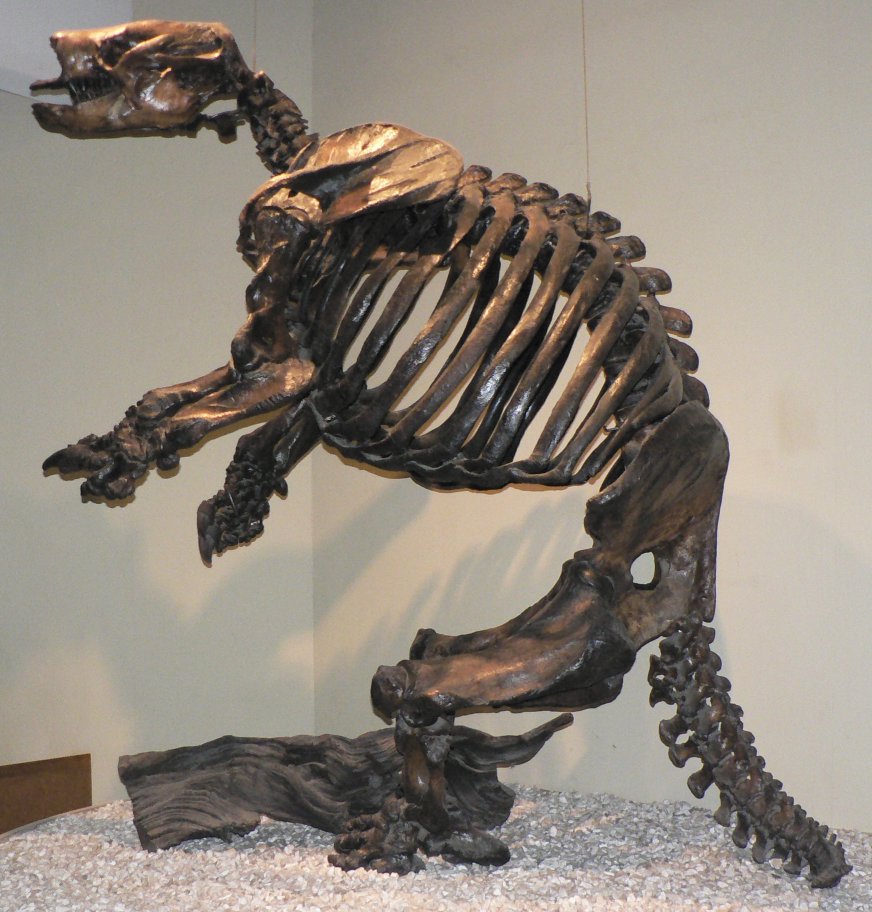- Paramylodon
Taxobox
name = "Paramylodon"
fossil_range = latePliocene toPleistocene

image_width = 240px
image_caption = Harlan's Ground Sloth ("Paramylodon harlani")
regnum =Animal ia
phylum =Chordata
classis =Mammalia
superordo =Xenarthra
ordo =Pilosa
familia = †Mylodontidae
subfamilia = †Mylodontinae
genus = †"Paramylodon"
genus_authority = Brown, 1903
species = †"P. harlani""Paramylodon" is an extinct genus of
ground sloth known from North America deposits in Mexico and the United States. Currently there is just one recognized species, "P. harlani", that is commonly referred to as Harlan's ground sloth in honor of American paleontologist Dr. Richard Harlan who first discovered and described a lower jaw in 1835. "Paramylodon" exhibits an interesting character of having had dermal ossicles, small bones embedded in the skin. This would have provided an interesting degree of protection to the animal, and this character is also shared by the South American "Mylodon".Taxonomic History
The genus was created by Brown (1903) with the species "P. nebrascensis". The skull showed a number of characters similar to that of "Mylodon harlani", which was also known from North America, but differed in the number of teeth present in the maxilla. "Paramylodon" had four teeth in the upper dentition, similar to that of "Grypotherium darwini" (="Mylodon darwini"), but the then recognized genus of "
Mylodon " possessed five upper teeth. "P. nebrascensis" was later considered to be a junior synonym of "M. harlani" by Stock (1925) given the large number of specimens from theLa Brea Tar Pits that showed the presence of the upper caniniform to be variably lost in some specimens and retained in others. Thus the typical dental formula for the species of "harlani" is 5/4. Work by Kraglievich (1928) sorted through the long standing historical confusion concerning the taxonomic validity of "Mylodon " and "Glossotherium ", and determined what the type species of each genus was. An additional result was to recognize "Paramylodon" as generically different from "Mylodon" of South America and "P. harlani" was used as the species name as it had seniority over "P. nebrascensis".Until recently, "Paramylodon" was also viewed as a subspecies of "
Glossotherium " and a number of institutions listed their specimens as "Glossotherium harlani" in part to work by Robertson (1976). "Paramylodon" is generically distinct from the South American genus of "Glossotherium" (see McAfee, 2007), although some question remains regarding the relationship of the late Blancan specimens that have been tentatively assigned as "Glossotherium" chapadmalense" due to their seeming similarity to the South American species of the same name.References
* (1903): A new genus of ground sloth from the Pleistocene of Nebraska. "Bulletin of the American Museum of Natural History", 19:569-583.
* (1935): Medical and physical researches. pp. 271-275; 314-336.
* (1928): "Mylodon Darwin" Owen, es la especie genotipo de "Mylodon" Ow. "Revista de la Sociedad Argentina de Ciencias Naturales, Physis": 9(33): 169-185.
* (2007): "Reassessing the Taxonomy and Affinities of the Mylodontinae Sloths, Glossotherium and Paramylodon (Mammalia: Xenarthra: Tardigrada)". Ph.D. Dissertation, Northern Illinois University. DeKalb, IL: 177pp.
* (1976): Latest Pliestocene mammals from Haile XV A, Alachua County, Florida. "Bulletin of the Florida State Museum", 20(3):111-186.
* (1925): "Cenozoic gravigrade edentates of western North America with special reference to the Pleistocene Megalonychinae and Mylodontidae of Rancho La Brea". Carnegie Institute of Washington, 331: 1-206.External links
* [http://www.sloth-world.org Sloth World: an on-line bibliography]
* [http://www.tarpits.org/education/guide/flora/sloth.html Page Museum: info on ground sloths from the La Brea tar pits]
Wikimedia Foundation. 2010.
